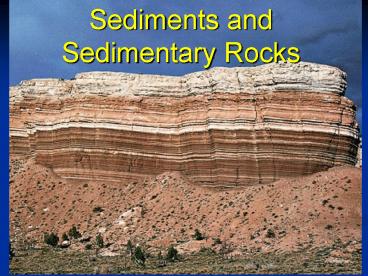Sediments and Sedimentary Rocks - PowerPoint PPT Presentation
1 / 40
Title: Sediments and Sedimentary Rocks
1
Sediments and Sedimentary Rocks
2
Transport and deposition of clastic sediment
Law It all goes down hill
Clastic particles physically transported rock
fragments produced by weathering of pre-existing
rocks. Clastic sediments accumulations of
clastic particles
Sedimentary rock (a) Rock resulting from the
consolidation of loose sediment that has been
derived from previously existing rocks and
accumulated in layers (clastic) (b) Rock formed
by the precipitation of minerals from solution by
either organic or inorganic processes (chemical)
3
Sedimentary rocks
- Volume of upper crust
- Area of continents
- Record of geological events e.g. Himalayas will
someday be sediment - Mt. Everest has fossiliferous limestones at the
summit
5
75
4
Sediment stages
1. Weathering
2. Erosion
3. Transportation via water, glaciers and wind
4. Deposition
5. Burial and compaction
6. Diagenesis
5
Transport affects the type of sediment
- Movement of sediment by wind, ice or water.
- Mode of transport produces distinctive deposits.
- Most sediments are carried by rivers 25 billion
tons/year - Strong currents faster than 50cm/s carries
gravel finer material - Moderately strong currents 20-50cm/s carries sand
- Weak currents slower than 20cm/s muds and silt
6
Sorting
- Sorting measure of the variation in the range
of grain sizes in a clastic rock or sediment. - Well-sorted sediments indicate that they have
been subjected to prolonged water or wind
action. - Poorly-sorted sediments are either not
far-removed from their source or deposited by
glaciers.
7
Roundness
- Roundness measure of how rounded the corners
are - Angular grains close to its source
- Rounded grains transported for a great distance
8
Sedimentation
- Clastic sediments Results from change in
velocity of carrying medium - Siliciclastic particles are mostly silicates
(sandstone) - Sediments are sorted river channel has coarse
sediment, banks fines sediment - Chemical sediments form near place of deposition
usually from seawater (carbonate rocks) - Biochemical sediments undissolved mineral
remains or organisms and minerals precipitated
by biological processes (coral, shells) - Sedimentation in ocean
- Currents are slow, only very fine material does
not settle - Fresh water meets saline water results in
precipitation.
Why is the ocean saline?
Rivers carry dissolved matter to the ocean,
evaporation concentrates the salts
9
Sedimentary environments I
Variations in 1. kind and amount of water, 2.
topography and 3. biological activity
10
Clastic Sedimentary environment
Dominated by actions of waves, tides and currents
Primary influenced by currents
Intensity of weathering Low Medium High Quartz
Quartz Quartz Feldspar Feldspar Clay
minerals Mica Mica Pyroxene Clay
minerals Amphibole
11
Chemical and biochemical sedimentary environment
12
Sedimentary structures
Bedding or stratification parallel layers of
grains of different size or kind. Whats
up Cross bedding sets of bedded material
deposited at angles as large as 35o. Graded
bedding coarse grains at base and progressively
finer grains towards the top. Ripples small
dunes of sand or silt whose long dimension is at
right angles with the current. Bioturbation
remnants of burrows and tunnels by clams worms etc
13
Cross bedding I
14
Cross bedding II
Grains are deposited on the lee side of the dune
15
Ripples
16
A-Symmetrical ripples
17
Modern rippled sand
18
Ripple Marks
19
Making ripples
20
Bioturbation
21
Continental slope
22
Turbidity currents
- Suspension of water, sand, and mud that moves
downslope (often very rapidly) due to its greater
density than that of the surrounding water (often
triggered by earthquakes) - Speed of turbidity currents first appreciated in
1920 breaking of phone lines in the Atlantic
also gave indication of distance traveled by a
single deposit - These turbidity currents can result in Tsunamis
23
Location of origin of turbidity currents
24
Graded bedding I
Scale can be meters to centimeters
25
Graded bedding II
26
River sediment
Bedding sequence record a history of events on
the Earths surface
27
Diagenetic processes I
Sediments are buried compacted and lithified at
shallow depths in the Earths crust.
or subducted where they are subjected to high
pressure and temperature
Diagenesis process- physical and chemical- that
changes sediments in sedimentary rocks
28
Diagenetic process II
Compaction squeezes out the water
Precipitation addition of new minerals cements
the sediment particles
Compaction squeezes out the water
29
Classes of clastic sediments
30
Relative abundance of sediments
31
Clastic rocks
32
Mineralogy of sandstone
33
Classification of (bio)chemical sediments
34
Carbonate platforms I
35
Carbonate platforms II
Within the reef lagoon, growth of
carbonate-secreting organisms, including
forminefera, coral, algae and molusks, is rapid,
and carbonate sediments form quickly
Eventually a carbonate platform grows with steep
sides towards the sea
If sealevel rises, the reef continues to grow
towards the light and lagoon sedimentation
outpaces sedimentation in the open ocean
36
Coral reefs and atolls I
Bora Bora atoll, South Pacifc
37
Coral reefs and atolls II
Process first described by Charles Darwin
38
Chemical and biochemical sedimentsI
Reefal limestone
39
Chemical and biochemical sediments II
- Evaporites precipitations due to evaporating
seawater. - arid climate
- freshwater supply from rivers is low
- connections to open sea are restricted
- Silica sediment chert
- Source of silica diatoms or other silicate
microorganisms - - Diagenetic alteration
- Iron oxide
- Banded iron formation iron ore
- Older formed when the atmosphere had less oxygen
- Ocean contained oxygen producing microorganism
oxidizing Fe
- Phosphorites
- Cold deep ocean water rising along the
continental margin - deep ocean water rich in phosphorous
40
Evaporites
2. Reduced exchange with open sea
1. During Miocene, the Mediterranean became a
shallow evaporite basin
3. Evaporation removed water
4. Fresh water inflow waslimited
5. Gypsum and halite crystalize first formig
evaportites

